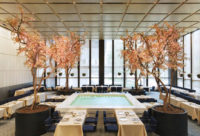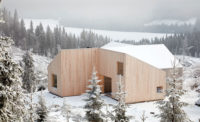Shotgun Chameleon Home by Zui Ng
Houston

The perforated steel screen provides privacy and shade for both interior and exterior living spaces on the second floor, which face the street.
Photo © Paul Hester

The perforated steel screen provides privacy and shade for both interior and exterior living spaces on the second floor, which face the street.
Photo © Paul Hester

The perforated steel screen (front) and wooden slats (side) help to passively ventilate the house.
Photo © Paul Hester

An external stair on the side of the house near the main entrance offers an additional means of entry to the balcony and upper story.
Photo © Paul Hester

The main entrance and external staircase are situated on the side of the house.
Photo © Paul Hester

The south-facing balcony looks out on the street.
Photo © Paul Hester

Sliding glass doors connect the second floor living/dining room to the balcony, creating an expanded living space.
Photo © Paul Hester

Sliding glass doors connect the second floor living/dining room to the balcony, creating an expanded living space.
Photo © Paul Hester

Double-height ceilings on the second story flood the living and dining areas with light.
Photo © Paul Hester

















Architects & Firms
Zui Ng’s flexible design for the Shotgun Chameleon house dates back to the 2006 Venice Biennale, where he exhibited plans for his post-Katrina New Orleans prototype. The Shotgun Chameleon, a part of the U.S. pavilion exhibition Rebuilding After Katrina (organized by Architectural Record for the Biennale), was never constructed. Nevertheless, the idea stuck with Ng for almost a decade and in 2015, he built the home in Houston’s historic Fourth Ward neighborhood for himself and his young family.
The designer says he fell in love with the site, which lies in the midst of “a constantly evolving urban fabric,” where older homes compete with new condominiums and residential towers. “The house had to reconcile with all the contradictions around it,” he says.
Studying the vernacular architecture of New Orleans, Ng noted how owners of old shotgun houses often rent out their front rooms—which have their own entries—for extra income. That observation prompted him to add an external staircase to the Shotgun Chameleon, making the building easily divisible into a duplex or live-work space.
Much of the design-build project’s modest budget (less than $300,000 for 2,000 square feet) went to the concrete foundation and steel-frame structure, filled in with 2-by-6-inch studs and plywood. Multiple windows in every room foster cross-ventilation: breezes flow through the south-facing porch and balcony to ventilate the house passively, while wooden slats on the sides and a perforated stainless-steel screen on the front afford privacy.
Ng calculated the angle of the roof over the balcony to shield the interior from the high summer sun but allow lower winter rays in. Other energy-efficient choices—a tankless water heater and mini-split air conditioners minimize energy consumption. Spray foam insulation and low-E, argon-gas-filled windows help maintain comfortable temperatures inside.
With 16-foot-high ceilings, the second floor living and dining room opens up to the balcony via sliding glass doors, creating an expanded living space. “We wanted to sustain the culture and history of the area,” Ng says, “so we built the porch and balcony to be able to interact with our neighbors.”
Faced with a diversity of architectural styles and a rapidly evolving neighborhood, the Shotgun Chameleon takes a subtle and smart approach to fitting in. “In Chinese, we have this saying: Slow water cuts rocks. Rather than confronting conflict head-on,” says Ng, “the philosophy is about moving slowly to mediate dissonance all around.”




















